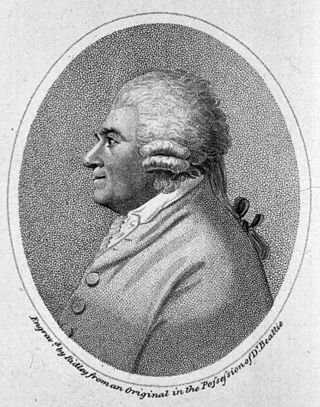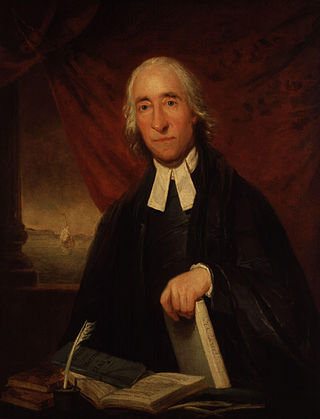
The Scottish Enlightenment was the period in 18th- and early-19th-century Scotland characterised by an outpouring of intellectual and scientific accomplishments. By the eighteenth century, Scotland had a network of parish schools in the Scottish Lowlands and five universities. The Enlightenment culture was based on close readings of new books, and intense discussions which took place daily at such intellectual gathering places in Edinburgh as The Select Society and, later, The Poker Club, as well as within Scotland's ancient universities.

James Beattie was a Scottish poet, moralist, and philosopher.

The Gentleman's Magazine was a monthly magazine founded in London, England, by Edward Cave in January 1731. It ran uninterrupted for almost 200 years, until 1922. It was the first to use the term magazine for a periodical. Samuel Johnson's first regular employment as a writer was with The Gentleman's Magazine.
Robert Hamilton was a Scottish mathematician and political economist. He was a founder member of the Royal Society of Edinburgh.

William Robertson FRSE FSA Scot was a Scottish historian, cleric, and educator who served as Principal of the University of Edinburgh, Chaplain of Stirling Castle, and one of the King's Chaplains in Scotland.

Rev. James Ramsay was a Scottish ship's surgeon, Anglican priest, and leading abolitionist in Great Britain.
John Gowdie (1682–1762) was a Scottish academic and Church of Scotland minister. He was Moderator of the General Assembly of the Church of Scotland in 1733.
James Byres of Tonley FRSE FSAScot FSA was a Scottish architect, antiquary and dealer in Old Master paintings and antiquities.

Sir James Hunter Blair, 1st Baronet FRSE was a Scottish banker, landowner and politician.
Sir Francis Grant Ogilvie CB FRSE was a Scottish educator, museum director, and scientist.
James Grainger was a Scottish doctor, poet and translator. He settled on St. Kitts from 1759 until his death of a fever on 16 December 1766. As a writer, he is best known for his poem The Sugar Cane, which is now valued as an important historical document.

Greyfriars Kirkyard is the graveyard surrounding Greyfriars Kirk in Edinburgh, Scotland. It is located at the southern edge of the Old Town, adjacent to George Heriot's School. Burials have been taking place since the late 16th century, and a number of notable Edinburgh residents are interred at Greyfriars. The Kirkyard is operated by City of Edinburgh Council in liaison with a charitable trust, which is linked to but separate from the church. The Kirkyard and its monuments are protected as a category A listed building.
William Johnson Temple (1739–1796) was an English cleric and essayist, now remembered as a correspondent of James Boswell.

Scottish literature in the eighteenth century is literature written in Scotland or by Scottish writers in the eighteenth century. It includes literature written in English, Scottish Gaelic and Scots, in forms including poetry, drama and novels. After the Union in 1707 Scottish literature developed a distinct national identity. Allan Ramsay led a "vernacular revival", the trend for pastoral poetry and developed the Habbie stanza. He was part of a community of poets working in Scots and English who included William Hamilton of Gilbertfield, Robert Crawford, Alexander Ross, William Hamilton of Bangour, Alison Rutherford Cockburn, and James Thomson. The eighteenth century was also a period of innovation in Gaelic vernacular poetry. Major figures included Rob Donn Mackay, Donnchadh Bàn Mac an t-Saoir, Uillean Ross and Alasdair mac Mhaighstir Alasdair, who helped inspire a new form of nature poetry. James Macpherson was the first Scottish poet to gain an international reputation, claiming to have found poetry written by Ossian. Robert Burns is widely regarded as the national poet.
Robert Morehead FRSE was a Scottish clergyman and poet who served as Dean of Edinburgh from 1818 to 1832.
Sir Adam Fergusson, 3rd Baronet of Kilkerran, FRSE LLD was a Scottish advocate, politician and slave-owner. He was described as able but humourless. Together with contemporaries such as Robert Dundas he was part of what was called the Scotch Ministry in parliament in the late 18th century. He was joint owner, with his brothers and members of the Hunter-Blair family, of plantations in Tobago and Jamaica and of several hundred enslaved African people.
Henry Grieve FRSE was a Scottish minister who served as Moderator of the General Assembly of the Church of Scotland in 1783. He was a co-founder of the Royal Society of Edinburgh in the same year. He was also one of the Deans in the Chapel Royal in Edinburgh and Chaplain in Ordinary to King George IV.
James MacKnight (1721-1800) was a Scottish minister and theological author, serving at the Old Kirk of Edinburgh. He is remembered for his book Harmony of the Gospels and as Moderator of the General Assembly of the Church of Scotland in 1769.

Midmar is a historic settlement in Aberdeenshire, lying north of Banchory and southwest of Inverurie. It is noted for its three stone circles and various standing stones. Midmar and Sunhoney are both recumbent stone circles.
James Paull (1782–1858) was a minister of the Church of Scotland who served as Moderator of the General Assembly in 1846, the highest position in the Scottish church. From 1852 he was also Chaplain in Ordinary to Queen Victoria in Scotland.









